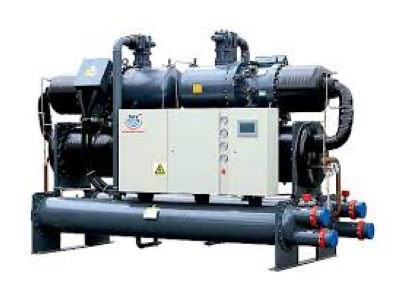Key Takeaway
A Variable Frequency Drive (VFD) is used in chillers to control the compressor speed. By adjusting the speed based on the cooling load, VFDs ensure the chiller operates efficiently. This modulation helps maintain optimal evaporator and condenser pressures. Even with a small power penalty from the VFD, the overall efficiency of the chiller improves significantly. VFDs also reduce energy consumption, lower operational costs, and extend the lifespan of the equipment. This makes them essential for achieving excellent part-load efficiency in chiller systems.
Importance of VFDs in Chiller Systems
The primary role of a VFD in a chiller system is to control the speed of the compressor motor. Traditional chillers operate at a fixed speed, which can lead to inefficiencies, especially during periods of low cooling demand. VFDs adjust the motor speed based on real-time cooling requirements, ensuring that the chiller operates at optimal efficiency at all times. This not only reduces energy consumption but also extends the lifespan of the equipment by minimizing wear and tear.
By precisely controlling the compressor speed, VFDs help maintain a consistent temperature, improving the overall comfort and stability of the environment. This is particularly crucial in industrial settings where temperature fluctuations can affect production processes and product quality. Moreover, VFDs contribute to reducing the start-up current surge, which can significantly lower electrical demand charges.

Benefits of VFDs for Chillers
Integrating Variable Frequency Drives (VFDs) into chiller systems offers several significant advantages, making them a crucial technology in industrial cooling applications. The primary benefit lies in energy savings, where VFDs adjust the motor speed according to the cooling demand. This adaptive control can result in substantial energy reductions, typically between 30% to 50%. These savings not only lower operational costs but also contribute to environmental sustainability by reducing carbon footprints.
Another key advantage is the mitigation of mechanical stress on chiller components. VFDs enable a soft start for motors, gradually increasing their speed rather than employing abrupt, full-power starts. This gentle startup minimizes wear and tear on mechanical parts, leading to fewer breakdowns and extending the operational lifespan of the equipment. Consequently, maintenance requirements are reduced, translating into additional cost savings and enhanced reliability of the chiller system.
Furthermore, VFDs improve the power factor of chiller operations, optimizing electrical efficiency and reducing overall power consumption. This enhancement in efficiency not only lowers utility bills but also supports stable and reliable performance of the entire cooling system.
You May Like to Read
Case Studies: VFDs in Chiller Systems
In the realm of industrial applications, Variable Frequency Drives (VFDs) have proven indispensable, particularly in optimizing chiller systems for enhanced efficiency and cost-effectiveness. A prime example comes from a leading pharmaceutical company that implemented VFDs within their chiller units. By doing so, they achieved a remarkable 40% reduction in energy consumption. This not only translated into substantial cost savings but also aligned with their sustainability objectives, significantly lowering their carbon footprint.
Similarly, a major data center strategically integrated VFDs into their cooling infrastructure. The adaptive nature of VFDs allowed precise control over chiller operations, efficiently managing fluctuating cooling demands. This implementation not only bolstered energy efficiency but also bolstered system reliability, ensuring consistent performance under varying load conditions.
These real-world case studies underscore the tangible advantages of VFDs in modern chiller systems across diverse industrial sectors. By enabling precise control and reducing energy wastage, VFDs not only optimize operational costs but also contribute to sustainability efforts, making them a pivotal technology in today’s industrial landscape.
Common Challenges and Solutions
Integrating Variable Frequency Drives (VFDs) into chiller systems offers substantial benefits, yet it comes with its share of challenges. One significant issue is harmonics, which can disrupt electrical systems and impact the performance of other equipment connected to the same power network. Harmonic filters provide an effective solution by mitigating these electrical interferences, ensuring smooth and efficient operation of the VFDs and maintaining overall system stability.
Another challenge often faced is the upfront cost of VFDs, which can be perceived as a barrier to adoption for some businesses. However, the long-term advantages in terms of energy savings and reduced maintenance expenses typically outweigh this initial investment. Proper training and ongoing maintenance practices are crucial to optimizing the benefits of VFDs. Ensuring that personnel are well-trained in the operation and upkeep of VFDs not only prevents potential issues but also enhances the efficiency and longevity of the chiller system, maximizing return on investment.
Future Trends in VFDs for Chillers
The future of Variable Frequency Drives (VFDs) in chiller systems holds exciting prospects, driven by technological advancements aimed at boosting efficiency and performance. One prominent trend emerging is the integration of smart VFDs. These next-generation devices leverage sophisticated algorithms and IoT connectivity to optimize chiller operations in real-time. By predicting cooling demands and autonomously adjusting settings, smart VFDs not only enhance efficiency but also provide detailed analytics for informed decision-making.
Another key trend is the development of compact and highly efficient VFDs. These innovations facilitate easier integration into existing chiller setups, enabling businesses to upgrade seamlessly to state-of-the-art VFD technology. Moreover, with an increasing global focus on sustainability, there’s a rising demand for energy-efficient solutions like VFDs. This growing market emphasis is expected to drive continuous innovation in VFD technology, fostering solutions that not only meet but exceed environmental standards while delivering superior performance.
Conclusion
In conclusion, VFDs play a crucial role in enhancing the efficiency and performance of chiller systems in industrial applications. By providing precise control over the motor speed, VFDs help reduce energy consumption, lower operational costs, and extend the lifespan of chiller components. Despite the initial investment and potential challenges, the long-term benefits of integrating VFDs into chiller systems are undeniable. As technology continues to advance, the future of VFDs in chillers looks bright, promising even greater efficiencies and performance improvements. Embracing VFD technology is a smart move for any industry looking to optimize their cooling systems and achieve sustainability goals.
